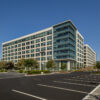The rise of autonomous vehicles (AVs) is more than just a shift in how we get from point A to point B; it’s changing the way we think about land, space, and how our cities are built. While much of the attention has focused on the technology itself, the ripple effects of AV adoption are expected to reshape how we design, develop, and value commercial properties.
For real estate professionals, city planners, developers, and investors, the question is no longer “if” AVs will impact commercial real estate – it’s “how much” and “how soon”
Rethinking the Role of Parking: Shrinking the Footprint
In many U.S. cities today, required parking ratios dictate how much space a developer must allocate for cars. These ratios often reflect an outdated assumption: that everyone drives and parks their own vehicle. Autonomous vehicles break this model.
Lower Car Ownership Means Less Demand for Parking
As shared AV fleets become more common, think of them as autonomous Ubers; fewer people will own personal cars. For urban dwellers, paying to own, maintain, and store a vehicle may no longer make sense when reliable, affordable transportation is a tap away. This will reduce the demand for on-site parking.
“Drop-off and Go” Will Become the Norm
Autonomous vehicles also have environmental impact because they don’t need to idle in parking spots. They can drop passengers at their destination and either pick up the next rider or head to a remote parking facility. These centralized lots, often located outside urban cores where land is cheaper, will consolidate vehicle storage and maintenance.
Smarter Parking Design
Parking infrastructures are changed with autonomous vehicles, the requirements look different. Without the need for drivers to open doors or walk between vehicles, AV
fleets can park closer together or even stack using automated systems. This compact design dramatically reduces the spatial footprint of parking spaces.
The bottom line is, developers can rethink parking not as a constraint, but as an opportunity to reclaim and reallocate land, most especially in dense, high-demand areas where every square foot matters.
Urban Development in the Age of AVs: Space Reimagined
The shift away from traditional parking needs doesn’t just impact individual properties. It has major implications for how cities grow and evolve.
Repurposing Real Estate: From Pavement to Profit
Think about the underutilized surface lots and massive parking garages that dominate many commercial developments. As AV adoption grows, these areas become prime candidates for redevelopment like apartments, retail, medical office, hospitality, or even green space.
In a city like Phoenix or Gilbert, where land value is rising and demand for mixed-use projects is strong, these underperforming assets could see dramatic appreciation once released from the obligation of parking.
Flexible Zoning Codes Will Lead the Way
To fully capitalize on this shift, municipalities will need to modernize their zoning codes. We’re already seeing cities reduce or eliminate minimum parking requirements, especially in areas served by public transit or targeted density. In the future, planners may even establish maximum parking allowances to discourage overbuilding and promote shared mobility.
Some forward-thinking architects are already designing “future-proof” parking structures that can be converted into other uses, like residential or coworking space. These adaptive reuse strategies make projects more resilient to changing transportation trends.
Better Streets, Healthier Cities
AVs also bring potential improvements to the public domain. With fewer cars circling blocks looking for parking, traffic congestion decreases. Fewer curb cuts, smaller driveways, and reduced vehicle volume allow cities to reclaim space for sidewalks, bike lanes, patios, or landscaping. This makes urban neighborhoods more walkable and attractive, a clear benefit for retail, hospitality, and office tenants.
Smarter Land Use and Lower Infrastructure Costs
When developers no longer dedicate a large percentage of a site to parking, they unlock more productive building areas. This creates room for housing, healthcare facilities, or retail, all while increasing density and improving project returns. Denser development also means lower infrastructure cost per resident or worker, a win for cities and taxpayers.
The Road Ahead: Planning for the Autonomous Future
Autonomous vehicles won’t transform cities overnight. But the shift is already underway, and forward-looking stakeholders are positioning themselves accordingly.
Cities that Act Now Will Attract the Future
Municipalities that proactively update codes, support shared mobility infrastructure, and partner with the private sector will attract new development, retain talent, and lead sustainability metrics.
CRE Investors and Developers Must Adapt
From underwriting fewer parking stalls, to exploring conversions of older garages, to designing flexible site plans – developers and owners who adjust now will be better positioned as the transportation landscape changes.
Tenants Will Seek Accessibility, Not Just Parking
Especially in sectors like healthcare or services, tenants will value locations that support easy drop-off access, integration with AVs, and pedestrian-friendly environments. The traditional value of “ample surface parking” may fade, replaced by seamless access and well-connected multimodal infrastructure.
The ICRE Advantage: Navigating What’s Next
At the ICRE Investment Team, we stay ahead of the trends that reshape how commercial real estate performs. Whether you’re a developer weighing zoning impacts, an investor exploring value-add plays, or a healthcare tenant seeking future-ready access, we help you align your strategy with where the market is heading – not where it’s been!
As Arizona and other high-growth regions prepare for an autonomous future, now is the time to consider how parking and mobility design influence long-term value. Let’s talk about how your next investment can move at the speed of innovation – not traffic.
















